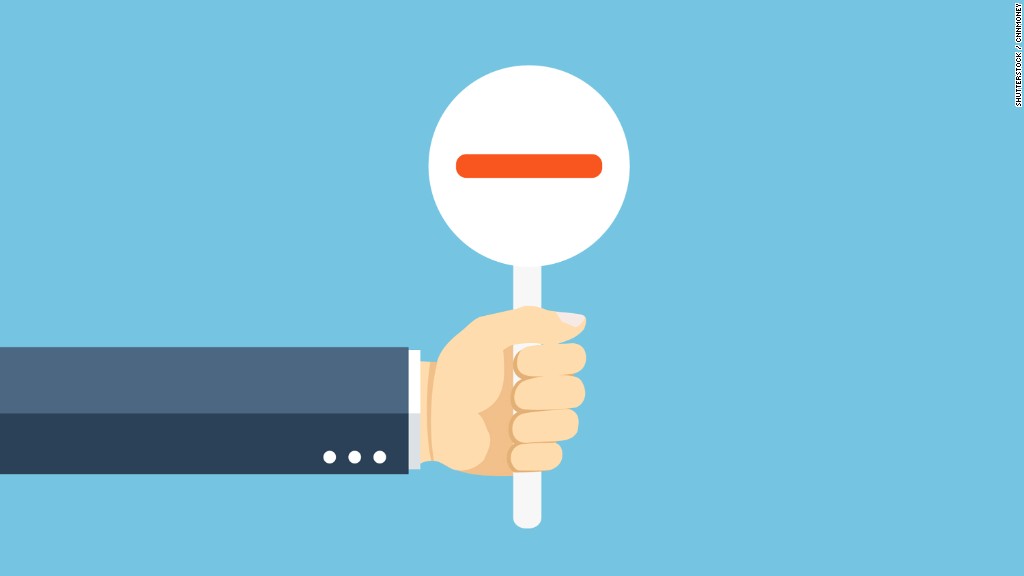
Negative interest rates could be coming to America.
"We're taking a look at them ... I wouldn't take those off the table," Federal Reserve chair Janet Yellen said Thursday at a Congressional hearing.
Yellen and other experts stress that the U.S. economy would have to get much worse before the Fed would contemplate such a move.
But if the U.S. does go negative, it wouldn't be alone. Five central banks -- Denmark, the Eurozone, Sweden, Switzerland and Japan -- now have negative interest rates. In fact, Sweden's central bank took its rates even deeper into negative territory on Thursday.
Negative interest rates as monetary policy was viewed as risky and highly experimental only a few years ago. Now it's becoming a trend, as central banks try almost anything to stimulate economic growth.
"It is feasible for the U.S. to do it, but the hurdle is really high," says Dan Sichel, a professor at Wellesley College and former Fed economist.
Related: Bank of Japan cuts key interest rate into negative territory
But what exactly are negative interest rates and how do they work?
Central banks have one key goal in mind when they cut rates: encourage people and businesses to spend their money.
That's why the Fed slashed interest rates to a historic low -- almost 0% -- in the midst of the financial crisis in 2008.
When people aren't earning any interest in the bank, they look around for other ways to make money.
Implementing a negative rate is an even bigger shock to jumpstart spending. In a technical sense, it means someone is actually being charged a penalty fee to hold money in a bank.
Related: Sweden's rate cut slams European banks
But you won't be penalized for your savings
To be clear, regular Joe's in Japan and Europe are NOT being charged by the bank for saving their money. That would cause outrage, so these countries have prevented it (at least for now).
It's the banks that are paying the penalty.
The central bank is the "banker's bank." Banks deposit some of their funds there, much in the same way people put their savings in the bank.
When the central bank turns interest rates negative, it charges banks a fee to hold SOME of their money at the central bank. A JPMorgan analysis found that only about 2.5% of total bank assets are subjected to the penalty fee.
It's small, but meaningful. The intent is to spur banks to go lend more.
Do they work?
There remains a great deal of mystery over whether negative rates work and how they impact complex global markets.
Asset manager Pimco warned in a new report Thursday of "unknown consequences" and an apparent "chilling effect" on financial markets.
Related: Janet Yellen: Market turmoil and dollar could hurt economy
It's hurting banks
Lending has held steady or gone up in most places and banks don't seem to be taking the dramatic step of holding their reserves in old fashioned cash vaults in an effort to avoid the fee.
But banks are getting squeezed. The big sell-off of European bank stocks is partly driven by fear that rates are going even more negative when the European Central Bank next meets in March.
"Banks find it hard to make money. Returns on anything are very low, even before negative rates," says Dominic Konstam, global head of rates research at Deutsche Bank.
But the reality is Europe has had negative rates since June 2014, so it's unclear why the sell-off is occurring now.
Related: Global central banks are running 'out of ammo'
In U.S., the economy will have to be in bad shape
For negative rates to come to the U.S., the economy would have to fall back into a recession.
And Fed members would have to believe in this policy. Last week, Cleveland Fed President Loretta Mester said she has concerns about even considering negative rates.
"If two years ago you asked me or anybody else with connections to the Fed about the possibility of negative rates, they would have said no way, never going to happen," says former Fed economist Sichel. "But given the experience of other central banks, it can be done."
--CNNMoney's Patrick Gillespie and Matt Egan contributed to this report.


